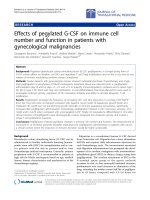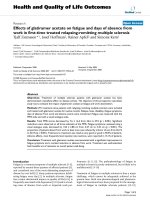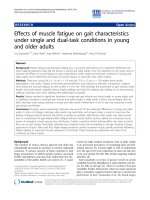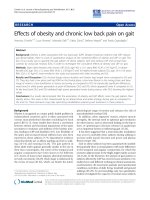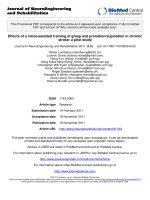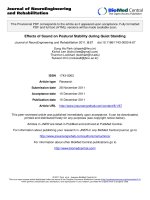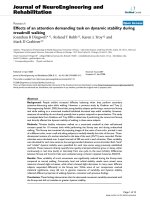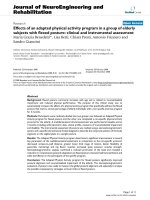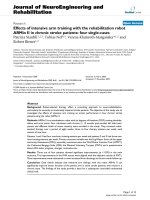báo cáo hóa học: " Effects of short duration stress management training on self-perceived depression, anxiety and stress in male automotive assembly workers: a quasi-experimental study" docx
Bạn đang xem bản rút gọn của tài liệu. Xem và tải ngay bản đầy đủ của tài liệu tại đây (346.27 KB, 9 trang )
BioMed Central
Page 1 of 9
(page number not for citation purposes)
Journal of Occupational Medicine
and Toxicology
Open Access
Research
Effects of short duration stress management training on
self-perceived depression, anxiety and stress in male automotive
assembly workers: a quasi-experimental study
BA Edimansyah
1
, BN Rusli*
2
and L Naing
3
Address:
1
School of Dental Sciences, Universiti Sains Malaysia Health Campus, 16150 Kubang Kerian, Kelantan, Malaysia,
2
Clinical School Johor
Bahru, Tan Sri Jeffrey Cheah School of Medicine, Monash University, JKR 1235, Bukit Azah, 80100 Johor Bahru, Johor, Malaysia and
3
Institute of
Medicine, National University of Brunei Darussalam, Jalan Tungku Link, Gadong BE 1410, Brunei Darussalam
Email: BA Edimansyah - ; BN Rusli* - ; L Naing -
* Corresponding author
Abstract
To examine the effects of short duration stress management training (SMT) on self-perceived
depression, anxiety and stress in male automotive assembly workers, 118 male automotive
workers from Pekan, Pahang (n = 60, mean age = 40.0 years, SD = 6.67) and Kota Bharu, Kelantan
(n = 58, mean age = 38.1 years, SD = 5.86) were assigned to experimental and control group,
respectively. A SMT program consisting of aerobic exercise, stress management manual, video
session, lecture, question and answer session, and pamphlet and poster session were conducted in
the experimental group. A validated short-form Malay version of the Depression Anxiety Stress
Scales (DASS-21) were self-administered before and after the intervention program in the
experimental and control group and their time and group interaction effects were examined using
the repeated measure ANOVA test. Results indicated that the mean (SD) scores for DASS-
Depression (p = 0.036) and DASS-Anxiety (p = 0.011) were significantly decreased, respectively,
after the intervention program in the experimental group as compared to the control group
(significant time-group interaction effects). No similar effect was observed for the mean (SD)
scores for DASS-Stress (p = 0.104). However, the mean (SD) scores for subscales of DASS-
Depression (Dysphoria, p = 0.01), DASS-Anxiety (Subjective Anxiety, p = 0.007, Situational
Anxiety, p = 0.048), and DASS-Stress (Nervous Arousal, p = 0.018, Easily Upset, p = 0.047) showed
significant time and group interaction effects. These findings suggest that short duration SMT is
effective in reducing some aspects of self-perceived depression, anxiety and stress in male
automotive workers.
Background
Job stress is a major occupational health problem in many
sectors of industries and automotive assembly industry
workers are one of several occupational groups who
report disproportionately high levels of job stress [1,2].
Studies have shown that job stress is a significant problem
in automotive assembly line workers [2-6]. For instance,
Karasek has highlighted high strain work (high demand
and low control) among machine-paced operative assem-
blers [3]. Kvanström reported that automotive assembly-
line work is often performed in a workplace environment
with physical problems, such as noise, vibrations and
Published: 21 November 2008
Journal of Occupational Medicine and Toxicology 2008, 3:28 doi:10.1186/1745-6673-3-28
Received: 25 September 2007
Accepted: 21 November 2008
This article is available from: />© 2008 Edimansyah et al; licensee BioMed Central Ltd.
This is an Open Access article distributed under the terms of the Creative Commons Attribution License ( />),
which permits unrestricted use, distribution, and reproduction in any medium, provided the original work is properly cited.
Journal of Occupational Medicine and Toxicology 2008, 3:28 />Page 2 of 9
(page number not for citation purposes)
dangerous machines that can be important factors of
stress. Furthermore, technical development in assembly-
line work, especially in large companies, has often
resulted in more complicated tasks for the workers who
may have difficulty in over-viewing all the steps in pro-
duction; this can easily build up a fear of the unknown
and, consequently, more stress [1]. Considering these
problems, it is desirable to implement a stress manage-
ment intervention in this occupational setting.
Several stress intervention programs have been developed
over the years to counter health problems in the work-
place. According to van der Klink et al. [7], interventions
designed to reduce job stress and its health effects can be
categorized according to their focus, content, method, and
duration. With regards to focus, intervention can be cate-
gorized into two basic approaches: a) individual-focused
approach, which aims to increase individual psychologi-
cal resources and responses such as coping; and b) organ-
ization-focused intervention, which aims to improve
stressful work environments through organizational
development and job redesign. The present study is aimed
at the individual-focused intervention.
There are various techniques in the individual-focused
approach that include exercise, stress management, relax-
ation training, physical fitness, cognitive-behavioural
training, meditation, biofeedback, hypnosis, yoga, and
interpersonal skills. A recent meta-analysis reported that
job stress management intervention studies that focus on
the individuals are effective in reducing workers' stress-
related complaints [7]. Among the stress management
interventions in the individual-oriented approach, exer-
cise and stress management are among the strategies that
are found to significantly reduce the long term effects of
health outcomes [7-14]. However, no study has tested the
effects of a short duration, easy-to-implement SMT that
could reduce depression, anxiety and stress in an occupa-
tional setting such as those in the automotive assembly
industry. Therefore, in the present study, we evaluate the
effectiveness of a short duration SMT in reducing self-per-
ceived depression, anxiety and stress among male auto-
motive assembly plant workers in Malaysia.
Methods
Study design
A quasi experimental study was conducted among male
automotive workers in Pahang and Kelantan from July to
September, 2006. This study is part of a national research
project entitled "Occupational Stress Intervention Study
in Petrochemical and Automotive Assembly Plants:
Developing and Evaluating a Stress Management Program
at Workplaces" (OSIS) under the research program "Qual-
ity of Work Life – National Occupational Risk Manage-
ment Study and National Injury Prevention" (NORMS)
funded by the Ministry of Science, Technology and Inno-
vation (MOSTI), Malaysia under its 8
th
Malaysia Plan.
Sample size estimation
Sample size was estimated using the PS Software for two
sample means, with power of 80% and alpha of 5%. Sam-
ple size calculation was based on the standard deviation
(SD = 10.12) for self-perceived stress in general practice
patients with mental health problems in Australia [15]
and the calculated sample size was 49. After considering a
10% non-response, the estimated sample size was 54
automotive workers.
Recruitment of study subjects
The reference population consists of automotive workers
in Malaysia. The source population includes workers in an
automotive plant in Pekan, Pahang and workers in an
automotive plant in Kota Bharu, Kelantan. The sampling
frame is the list of automotive workers available for
screening using the DASS questionnaire in Pekan, Pahang
(88 workers) and Kota Bharu, Kelantan (75 workers).
Inclusion criteria include male automotive workers and at
least one year of working experience. Exclusion criterion is
a history of medically confirmed mental illnesses. Based
on the inclusion and exclusion criteria, 60 automotive
workers were eligible in Pekan, Pahang (assigned to the
experimental group) and 58 automotive workers in Kota
Bharu, Kelantan (assigned to the control group).
Stress management training
Our intervention program consists of a short duration
SMT module that includes the following sessions: aerobic
exercise, pamphlet and poster session on stress reduction
through adopting a healthy lifestyle, review session of a
simplified and well illustrated manual on the prevention
and control of stress in the workplace, interactive lecture
session on stress management in the workplace, video ses-
sion on stress management in the workplace, and ques-
tion and answer session. The intervention program was
held in a public facility adjacent to the automotive plant
in Pekan, Pahang.
Session 1
Aerobic Exercise. The aerobic exercise session was con-
ducted by qualified aerobic instructors and consists of a
preparatory 15 minutes warming up stretching exercises
[13]. This was followed by low intensity walking and jog-
ging routines [16]. Participants were then taken through a
series of rhythmic dancing and running routines that
lasted about 30 minutes. In the last 15 minutes, partici-
pants carried out a cooling down manoeuvre that includes
deep breathing exercises and relaxation of over-stretched
muscles [16].
Journal of Occupational Medicine and Toxicology 2008, 3:28 />Page 3 of 9
(page number not for citation purposes)
Session 2
Pamphlet and Poster Session. This is an interactive pam-
phlet and poster session where participants were guided
by the researchers to the pamphlets and posters that
depict the nature, causes, and signs and symptoms of
stress, stress reduction through adopting a healthy life
style, and methods of managing stress in the workplace. A
short question and answer session was conducted to
improve the participants' understanding of the materials
presented.
Session 3
Manual Review Session. A simplified and well illustrated
manual on the prevention and control of stress in the
workplace was distributed to all participants and they
were asked to review it over the next 30 minutes followed
by a question and answer session.
Session 4
Lecture on Stress Management. This is an interactive lec-
ture session on stress management in the workplace and
designed to reinforce the participants' understanding of
occupational stress and a suggested plan towards stress
reduction and control. The key component of the lecture
is an elaboration of occupational stress, risk factors
involved, associated health impacts and ways to prevent
and control stress in the workplace. References were made
to the Job Demand Control Model of stress and how work
conditions of high job demand, low job control and poor
social support can result in severe stress and serious health
consequences. Participants were carefully guided as to the
various ways of dealing with stress at work and the impor-
tance of good social support in protecting workers from
severe stress.
Session 5
Video Session on Stress Management in the Workplace.
The video session is entitled "Stress Management in the
Malaysian Automotive Industry" and was produced by the
researchers as part of the research program, with permis-
sion and full cooperation from the automotive assembly
plant. The video previewed all processes of production in
the automotive industry. The aim of this session is to pro-
vide an overview of the working conditions in the auto-
motive assembly plant and how the working conditions
can contribute toward occupational stress. The video also
showed several simple methods of dealing with stress in
the workplace.
Session 6
Question and Answer Session. At the end of the video ses-
sion, the researchers conducted a question and answer
session with the participants. This session was aimed at
exploring several practical problems related to occupa-
tional stress encountered by the participants and discuss-
ing several options and suggestions in managing these
problems. Participants were asked to identify several
stressful situations that they had personally experienced at
work and how they cope with these stresses. Suggestions
were made to strengthen their coping skills including the
need to adopt the healthy lifestyle approach – regular
exercise, avoidance of tobacco, drugs, and alcohol, ade-
quate sleep and rest, and proper nutrition and dieting –
that has been shown to be beneficial in stress reduction.
Validated short-form Malay version of the depression
anxiety stress scales (DASS-21)
DASS-21 is the short-form of Lovibond and Lovibond's
42-item self-report which measures the negative emo-
tional states of depression, anxiety and stress [17]. The
questionnaire consists of three scales: DASS-Depression
Scale (Cronbach's alpha = 0.81), DASS-Anxiety Scale
(Cronbach's alpha = 0.85) and DASS-Stress Scale (Cron-
bach's alpha = 0.85) [18]. The DASS-Depression Scale
assesses dysphoria, hopelessness, devaluation of life, self-
deprecation, lack of interest/involvement, anhedonia and
subjective experience of anxious affect. The DASS-Anxiety
scale assesses autonomic arousal, skeletal muscle effects,
situational anxiety, and subjective experience of anxious
affect. The DASS-Stress scale is sensitive to levels of
chronic non-specific arousal. It assesses difficulty relaxing,
nervous arousal, and being easily upset/agitated, irritable/
over reactive, and impatient. Subjects are asked to use a 4-
point severity/frequency scale (0 = Did not apply to me at
all, 1 = Applied to me to some degree, or some of the time,
2 = Applied to me a considerable degree, or a good part of
the time, and 3 = Applied to me very much, or most of the
time) to rate the extent to which they have experienced
each state over the past week. Scores for DASS-Depression,
DASS-Anxiety and DASS-Stress were calculated by sum-
ming the scores for the relevant items, multiplying by 2
and converting these scores into percentile scores [17].
The DASS scale manual [17] provides a series of cut-off
values to classify individuals into 5 levels of severity (nor-
mal, mild, moderate, severe, and extremely severe). Based
on the cut-off percentiles, workers scoring less than 78
percentiles are considered normal; 78 to 87 percentiles as
mild; 85 to 95 percentiles as moderate; 95–98 percentiles
as severe; and 98–100 percentiles as extremely severe.
To examine the effect of short duration SMT intervention
program on self-perceived depression, anxiety and stress,
the DASS-21 questionnaires were self-administered to
both study groups before and after the intervention pro-
gram.
Statistical analysis
Data entry and analysis was done using SPSS version
12.0.1 (SPSS Inc, Chicago, IL, USA). Mean and standard
deviations (SD) were calculated for continuous variables,
Journal of Occupational Medicine and Toxicology 2008, 3:28 />Page 4 of 9
(page number not for citation purposes)
and frequencies and percentages for categorical variables.
Effectiveness of the short duration SMT program was
examined using the repeated measure ANOVA analysis
where the time-group interaction effect (within subject-
between subject) was modelled. Assumptions of the
repeated measure ANOVA include the following: histo-
gram of residuals for normality assumption and Levene's
test for equal variance assumption; sphericity assumption
is not necessary because the model includes only 2
repeated measures; model fitness will be checked by resid-
ual plots and lack-of-fit test; level of significance is set at α
= 0.05.
Results
Socio-demographic characteristics
A total of 118 workers (60 workers in experimental group
and 58 workers in control group) participated in this
study. Socio-demographic characteristics such as age, mar-
ital status, years of education, duration of work and salary
were compared between the two groups (Table 1). Except
for marital status, all socio-demographic characteristics
were found to be not significantly different between the
two study groups.
Effects of short duration SMT on mean (sd) scores for
DASS-depression, DASS-anxiety and DASS-stress scales
Table 2 and Figures 1, 2 and 3 show the effects of SMT on
the mean (SD) scores (pre- and post-intervention) for
DASS-Depression, DASS-Anxiety and DASS-Stress scales
in the experimental group as compared to those in the
control group. There are significantly reduced mean (SD)
scores for DASS-Depression (p = 0.036) and DASS-Anxiety
(p = 0.011) in the experimental group as compared to
those in the control group (significant time-group interac-
tion effects). However, there is no significant difference in
the mean (SD) scores (pre- and post-intervention) for
DASS-Stress (p = 0.104) in the experimental group as com-
pared to those in the control group (not significant time-
group interaction effect).
Effects of short duration SMT on mean (sd) scores for
DASS-depression, DASS-anxiety and DASS-stress subscales
Table 3 shows the effects of SMT on the mean (SD) scores
(pre- and post-intervention) for DASS-Depression, DASS-
Anxiety and DASS-Stress subscales in the experimental
group as compared to those in the control group. For
DASS-Depression Subscales, there is a significant time-
group interaction effect in the mean (SD) scores for dys-
phoria (p = 0.010) but not for evaluation of life (p =
0.200), hopelessness (p = 0.370), self-deprecation (p =
0.076), anhedonia (p = 0.352) and inertia (p = 0.350).
Meanwhile, for DASS-Anxiety Subscales, there are signifi-
cant time-group interaction effects in the mean (SD)
scores for anxiety (p = 0.007) and situational anxiety (p =
0.048), but not for skeletal muscle effect (p = 0.495) and
autonomic arousal (0.054). Whereas for DASS-Stress Sub-
scales, there are significant time-group interaction effects
in the mean (SD) scores for nervous arousal (p = 0.018)
and easily upset (p = 0.047) but not for difficulty relaxing
(p = 0.750) and irritable (p = 0.722).
Discussion
We examined the effects of short duration SMT on self-
perceived depression, anxiety and stress in automotive
workers using the validated short-form Malay version of
the Depression Anxiety Stress Scales (DASS-21). Results
indicated that SMT is effective in reducing some aspects of
self-perceived depression, anxiety, and stress in these
workers.
Blumenthal et al [13] have shown that combined exercise
for 35 minutes 3 times per week for 16 weeks plus weekly
1.5-hour SMT for 16 weeks was effective in reducing gen-
eral distress as measured by the General Health Question-
naire (p = 0.02), depressive symptoms as measured by the
Beck Depression Inventory (p = 0.02) and improved
markers of cardiovascular risk more than usual medical
care alone. Our present study also shows that short dura-
tion SMT is effective in reducing some aspects of self-per-
ceived depression, anxiety and stress in automotive
workers. These findings are very important because auto-
motive assembly workers tend to be busy, and long dura-
Table 1: Socio-demographic characteristics of experimental group (n = 60) and control group (n = 58)
Socio-demographic characteristics Experimental group (n = 60) Control group (n = 58) t-statistic (df) X
2
(df) p-value
Mean (SD) Mean (SD)
Age (year) 40.0 (6.67) 38.1 (5.86) 1.580 (116)0.117
Salary (RM) 2952.7 (2048.14) 2645.46 (2058.34) 0.782 (108)0.436
Duration of work (year) 12.4 (10.60) 5.6 (5.26) 1.795 (115)0.075
Education (year) 14.0 (2.31) 14.1 (2.09) -0.339 (116)0.735
Marital status No. (%)
No. (%)
a. Single 3 (5.0) 42 (72.4) 56.8 (1)<0.001
b. Married 57 (95.0) 16 (27.6)
Journal of Occupational Medicine and Toxicology 2008, 3:28 />Page 5 of 9
(page number not for citation purposes)
tion of training would be less likely to be used. However,
it should be noted that our study did not consider compli-
ance or continuation of the present training. Further
research must be carried out to explore how the subjects
would respond to longer duration training of weeks or
even months.
To our knowledge, there is only one empirical study that
examined the immediate effects of an intervention pro-
gram [19]. Taniguchi et al [19] have shown the immediate
effects of a stress management program that combines lec-
ture (1 hour) and relaxation training (10 minutes) on Jap-
anese female medical co-workers indicated that salivary
immunoglobulin A (s-IgA) levels in the relaxation group
increased after relaxation training compared to those in
the control group (p = 0.03). However, no significant
relaxation training effects were found in the Profile Mood
States (POMS) subscales for tension-anxiety (p = 0.870),
depression-dejection (p = 0.161), anger-hostility (p =
0.937), vigor-activity (p = 0.657) and fatigue-inertia (p =
0.212), except for confusion (p = 0.036). Since the scope
of the present study is only focused on responses using
Comparing mean (sd) scores for DASS-depression between experimental group (n = 60) and control group (n = 58) (repeated measure anova)Figure 1
Comparing mean (sd) scores for DASS-depression between experimental group (n = 60) and control group (n
= 58) (repeated measure anova).
Comparing mean (sd) scores for DASS-anxiety between experimental group (n = 60) and control group (n = 58) (repeated measure anova)Figure 2
Comparing mean (sd) scores for DASS-anxiety between experimental group (n = 60) and control group (n =
58) (repeated measure anova).
Journal of Occupational Medicine and Toxicology 2008, 3:28 />Page 6 of 9
(page number not for citation purposes)
self-perceived DASS21 questionnaire, we suggest that fur-
ther studies using physiological responses are needed to
explore the effectiveness of SMT.
Studies that examine the effects of short duration SMT on
stressful workers are seriously lacking. One reason for this
lack is that senior managers in the same organization pre-
sume that formal exercise training and SMT programs are
time-consuming, expensive and workers cannot spare the
time to practice any coping skills. Another reason is that
provided by Yung et al. [20], with given examples in hos-
pital setting, that there is the belief that such intervention
programs usually require manpower and resources that
could be better spent on other patient care than on staff
care. However, given the high stress levels reported among
automotive workers in previous studies, including those
in Malaysia, these reasons are not sufficient to ignore the
well-being of automotive assembly workers. Therefore,
short duration intervention programs such as SMT are
needed for automotive workers in Malaysia.
In this intervention program, the experimental group
received a short duration SMT program (aerobic exercise,
manual, video session, lecture, pamphlet and poster ses-
sions) that shows improvement in the mean (SD) scores
for DASS-Depression and DASS-Anxiety but not for DASS-
Stress. However, when we examined the mean (SD) scores
for DASS-Stress (pre and post-intervention), the mean
(SD) scores were slightly reduced after the intervention
program. In an effort to identify which subscales of DASS-
Depression, DASS-Anxiety and DASS-Stress are signifi-
cantly contributing towards improvement in the mean
(SD) scores, we also analysed the effects of the interven-
tion program on each subscale of the DASS-Depression,
DASS-Anxiety and DASS-Stress scales. With regards to
DASS-Depression subscales, we found that the mean (SD)
score for dysphoria (p = 0.010) was significantly reduced
after intervention. This could be due to the effect of the
SMT intervention program, especially the aerobic exercise.
However, the mean (SD) scores (pre- and post-interven-
tion) for DASS-Depression subscales such as devaluation
Comparing mean (sd) scores for DASS-stress between experimental group (n = 60) and control group (n = 58) (repeated measure anova)Figure 3
Comparing mean (sd) scores for DASS-stress between experimental group (n = 60) and control group (n = 58)
(repeated measure anova).
Table 2: Comparing mean (sd) scores for DASS-depression, DASS-anxiety and DASS-stress between experimental group (n = 60) and
control group (n = 58) (repeated measure anova)
Variables Time Experimental group (n = 60) Control group (n = 58) F stat. (df)
a
p value
Mean (SD) Mean (SD)
DASS-Depression Pre 5.1 (3.07) 4.8 (3.43) 6.15 (1;116) 0.036
Post 3.5 (2.88) 4.7 (3.69)
DASS-Anxiety Pre 4.3 (3.17) 4.8 (3.49) 6.621(1;116) 0.011
Post 2.8 (2.77) 5.0 (2.95)
DASS-Stress Pre 6.7 (3.35) 8.2 (3.62) 2.686 (1;116) 0.104
Post 5.5 (2.80) 8.1 (3.47)
a
time-group interaction effect
Journal of Occupational Medicine and Toxicology 2008, 3:28 />Page 7 of 9
(page number not for citation purposes)
Table 3: Comparing mean (sd) scores for DASS-depression, DASS-anxiety and DASS-stress subscales between experimental group (n
= 60) and control group (n = 58) (repeated measure anova)
Experimental group n = 60 Control group n = 58
DASS-depression subscales Time Mean (SD) Mean (SD) F stat. (df)
a
p value
Dysphoria Pre 1.0 (0.59) 0.7 (0.78) 6.810
(1;116)
0.010
Post 0.6 (0.61) 0.8 (0.83)
Devaluation of Life Pre 0.8 (1.06) 0.9 (1.14) 1.659
(1;116)
0.200
Post 0.6 (0.82) 1.0 (1.27)
Hopelessness Pre 0.6 (0.62) 0.8 (0.92) 0.811
(1;116)
0.370
Post 0.4 (0.52) 0.7 (0.87)
Self Deprecation Pre 0.8 (0.70) 0.8 (0.81) 3.201
(1;116)
0.076
Post 0.6 (0.62) 0.8 (0.80)
Anhedonia Pre 0.8 (0.77) 0.6 (0.73) 0.874
(1;116)
0.352
Post 0.6 (0.76) 0.6 (0.77)
Inertia Pre 1.1 (0.71) 1.0 (0.79) 0.882
(1;116)
0.350
Post 0.9 (0.65) 0.8 (0.87)
DASS-anxiety subscales
Subjective Anxiety Pre 0.7 (0.89) 0.7 (0.12) 7.058
(1;116)
0.007
Post 0.5 (0.77) 1.2 (1.30)
Situational Anxiety Pre 1.0 (0.76) 1.2 (1.02) 4.009
(1;116)
0.048
Post 0.8 (0.62) 1.3 (0.96)
Skeletal Muscle Effect Pre 0.5 (0.68) 0.5 (0.82) 0.469
(1;116)
0.495
Post 0.3 (0.54) 0.5 (0.68)
Autonomic Arousal Pre 2.2 (1.58) 2.4 (1.68) 3.791
(1;116)
0.054
Post 1.3 (1.43) 2.1 (1.64)
DASS-stress subscales
Difficulty Relaxing Pre 1.9 (1.14) 1.8 (1.38) 0.102
(1;116)
0.750
Post 1.6 (0.72) 1.5 (1.22)
Nervous Arousal Pre 0.9 (0.77) 1.0 (0.90) 5.778
(1;116)
0.018
Post 0.6 (0.59) 1.1 (0.81)
Easily Upset Pre 1.0 (0.68) 1.6 (0.81) 4.042
(1;116)
0.047
Post 0.9 (0.70) 1.1 (0.97)
Irritable Pre 1.9 (1.16) 2.3 (1.41) 0.127
(1;116)
0.722
Post 1.4 (1.03) 1.9 (1.51)
a
time and group interaction effect
Journal of Occupational Medicine and Toxicology 2008, 3:28 />Page 8 of 9
(page number not for citation purposes)
of life (p = 0.200), hopelessness (p = 0.370), self depreca-
tion (p = 0.076), anhedonia (p = 0.352) and inertia (p =
0.350) were not significantly different in the experimental
group as compared to those in the control group. All
mean (SD) scores for DASS-Depression subscales were
slightly reduced after the intervention program.
With regards to the mean (SD) scores for DASS-Anxiety
subscales, we found that the mean (SD) scores for subjec-
tive anxiety (p = 0.007) and situational anxiety (p = 0.048)
were significantly reduced after intervention. This suggests
that subjective anxiety, as explained by "I had a feeling of
faintness" and "I felt scared without any good reason" and
situational anxiety as explained by "I found myself in sit-
uations that made me so anxious I was most relieved
when they ended" are statistically significantly reduced.
Meanwhile, the mean (SD) scores for self-perceived DASS-
Anxiety subscales, such as skeletal muscle effect (p =
0.495) and autonomic arousal (p = 0.054) were not signif-
icantly different pre- and post-intervention. However,
when we examined the mean (SD) scores for pre- and
post-intervention, all the mean (SD) scores for DASS-Anx-
iety subscales were also reduced.
Whereas for DASS-Stress subscales, we found that the
mean (SD) scores for nervous arousal ("I felt that I was
using a lot of nervous energy") (p = 0.018) and easily
upset ("I found myself getting upset by quite trivial things
and I found myself getting upset rather easily") (p =
0.047) were significantly reduced after intervention.
In this study, we suggest that short duration SMT interven-
tion program, combining aerobic exercise, manual, video
session, lecture, pamphlet and poster presentation, and
question and answer session, could be used in automotive
industries as part of their social and welfare program and
implemented as a weekend or monthly activity for the
workers.
Limitations of the study
Several limitations of this study should be noted. Firstly,
in the aerobic exercise training, participants were trained
by instructors only once. The exercise training of approxi-
mately one hour may have been too short. Therefore, it is
necessary to encourage the participants towards regular
practice. Because self-perceived depression, anxiety and
stress were measured before and after the short duration
SMT program, therefore, the findings related to the short-
term effects could not be compared with previous studies
that were mostly related to long-term effects. The present
study could not provide data on how long the effects
remain after the intervention program, or on any cumula-
tive effects of the intervention program through SMT pro-
gram.
Conclusion
Reducing depression, anxiety and stress in automotive
assembly workers by stress intervention program is an
important issue. The present study was conducted to
examine the effects of short duration SMT on self-per-
ceived depression, anxiety and stress in automotive work-
ers using the validated short-form Malay version of the
Depression Anxiety Stress Scales (DASS-21). Results indi-
cated that SMT is effective in reducing some aspects of self-
perceived depression, anxiety, and stress in these workers.
Therefore, intervention programs to reduce stress, anxiety,
and depression in the workplace may facilitate automo-
tive workers to provide high-quality service in an automo-
tive assembly plant setting.
Competing interests
The authors declare that they have no competing interests.
Authors' contributions
RBN, EBA and LN contributed equally to the design and
conduct of the survey, analysis of the results, drafting and
critical revision of the manuscript. RBN, EBA and LN read
and approved the final version of the manuscript
Acknowledgements
The authors would like to acknowledge, with gratitude, financial support
from the IRPA research grant of the Ministry of Science, Technology and
Innovation (MOSTI) (project no: 06-02-05-2079-PR0061/09-03) in the
RMK 8 budget. We would also like to thank Miss Mazalisah Binti Matsah,
Dr. Ahmad Syaarani Bin Yasin, Dr. Nik Khairol Reza Bin Md Yazin for tech-
nical assistance and Mr. Kamarudin Hussin, Research Assistant, for secre-
tarial assistance.
References
1. KvarnstrÖm S: Stress prevention for blue-collar workers in
assembly-line production. Geneva: International Labour Office
(ILO); 1997:1-32.
2. Oleske DM, Neelakantan J, Andersson GB, Hinrichs BG, Lavender SA,
Morrissey MJ, Zold-Kilbourn P, Taylor E: Factors affecting recov-
ery from work-related, low back disorders in autoworkers.
Arch Phys Med Rehabil 2004, 85(8):1362-1364.
3. Karasek R, Baker D, Marxer F, Ahlbom A, Theorell T: Job decision
latitude, job demands, and cardiovascular disease: a prospec-
tive study of Swedish men. Am J Public Health 1981,
71(7):694-705.
4. Kumlin L, Latscha G, Orth-Gomer K, Dimberg L, Lanoiselee C, Simon
A, Eriksson B: Marital status and cardiovascular risk in French
and Swedish automotive industry workers – cross sectional
results from the Renault-Volvo Coeur study. J Intern Med 2001,
249(4):315-323.
5. Hanse JJ, Forsman M: Identification and analysis of unsatisfac-
tory psychosocial work situations: a participatory approach
employing video-computer interaction. Appl Ergon 2001,
32(1):23-29.
6. Lottridge D: Work at the Uddevalla Volvo Plant from the per-
spective of the demand-control model. Bull Sci Tech Society
2004, 24:435-440.
7. Klink JJ van der, Blonk RW, Schene AH, van Dijk FJ: The benefits of
interventions for work-related stress. Am J Public Health 2001,
91:270-276.
8. Shimazu A, Okada Y, Sakamoto M, Miura M: Effects of stress man-
agement program for teachers in Japan: A pilot study. J Occup
Health 2003, 45:202-204.
9. Rhenen WV, Roland WB, Blonk Jac JL, Klink JJ van der, Frank JH, van
Dijk Wilmar B: The effect of a cognitive and a physical stress-
Publish with BioMed Central and every
scientist can read your work free of charge
"BioMed Central will be the most significant development for
disseminating the results of biomedical research in our lifetime."
Sir Paul Nurse, Cancer Research UK
Your research papers will be:
available free of charge to the entire biomedical community
peer reviewed and published immediately upon acceptance
cited in PubMed and archived on PubMed Central
yours — you keep the copyright
Submit your manuscript here:
/>BioMedcentral
Journal of Occupational Medicine and Toxicology 2008, 3:28 />Page 9 of 9
(page number not for citation purposes)
reducing programme on psychological complaints. Int Arch
Occup Environ Health 2005, 78:139-148.
10. Kagan N, Kagan H, Watson MG: Stress reduction in the work-
place: The effectiveness of psycholoedutional programs. J
Counseling Psycho 1995, 42(1):71-78.
11. Reynolds S, Shapiro D: Stress reduction in transition: Concep-
tual problems in the design, implementation and evaluation
of worksite stress management intervention. Human Relations
1991, 44:717-733.
12. Selkowitz D, Kulig K, Poppert E, Flanagan S, Matthews N, Beneck G,
Popovich J Jr, Lona J, Yamada K, Burke W, Ervin C, Powers C, Physical
Theraphy Clinical Research Network (PTClinResNet): The imme-
diate and long-term effects of exercise and patient education
on physical, functional, and quality-of-life outcome measures
after single-level lumbar microdiscectomy: a randomized
controlled trial protocol. BMC Musculoskeletal Disorders 2006,
7(70):.
13. Blumenthal J, Sherwood A, Babyak M, Watkins L, Waugh R, Georgia-
des A, Bacon S, Hayano J, Coleman R, Hinderliter A: Effects of exer-
cise and stress management training on markers of
cardiovascular risk in patients with ischemic heart disease: A
randomized controlled trial. JAMA 2005, 293(13):1626-1634.
14. Blumenthal J, Sherwood A, Babyak M, Watkins L, Waugh R, Georgia-
des A, Bacon S, Hayano J, Coleman R, Hinderliter A: Stress man-
agement and exercise training in cardiac patients with
myocardial ischemia: effects on prognosis and evaluation of
mechanisms. Arch Intern Med 1997, 157:2213-2223.
15. Vines R, Richards J, Thomson D, Brechman-Toussaint M, Kluin M,
Vesely L: Clinical psychology in general practice: a cohort
study. Med J Aust 2004, 181:74-77.
16. Seaward BK: Managing stress:principles and strategies for
health and well-being. Sudbury: Jones and Bartlett Publishers;
2004.
17. Lovibond SH, Lovibond PF: Manual for the Depression Anxiety
Stress Scales. 2 edition. 2nd edition. Sydney: School of Psychol-
ogy, University of New South Wales; 2002.
18. Mazalisah M, Rusli B, Naing L, Edimansyah B: Validation of the
Malay version of the Depression Anxiety Stress Scales 21-
item in an automobile industry. Malaysian J Med Sci 2005,
12(Suppl 1):.
19. Taniguchi T, Hirokawa K, Tsuchiya M, Kawakami N: The immedi-
ate effects of 10-minute relaxation training on salivary
immunoglobulin A (s-IgA) and mood state for Japanese
female medical co-workers. Acta Med Okayama 2007,
61(3):139-145.
20. Yung P, Fung M, Chan T, Lau B: Relaxation training methods for
nurse managers in Hong Kong: a controlled study. Int J Ment
Health Nurs 2004, 13:255-261.
